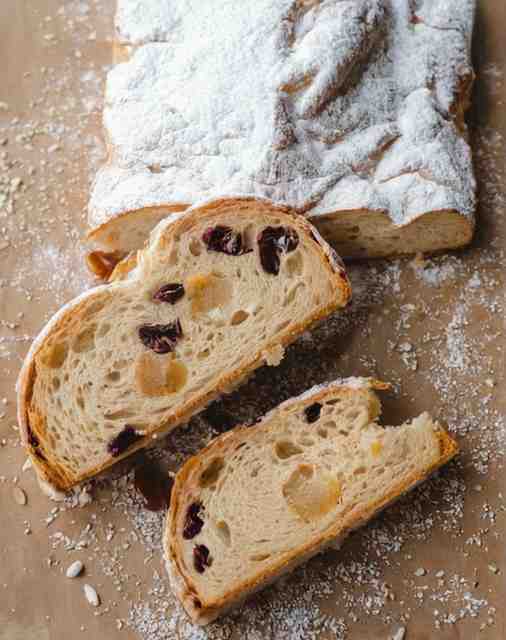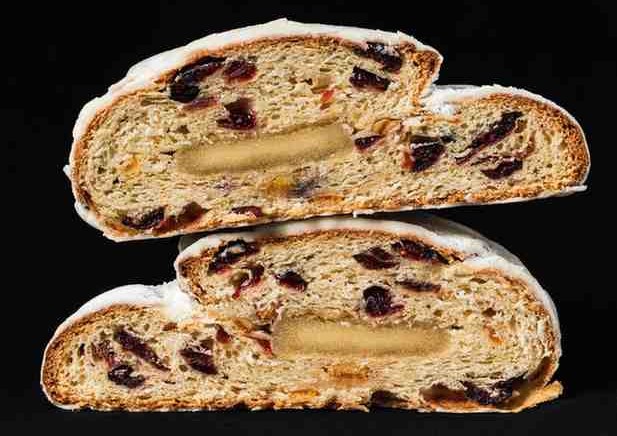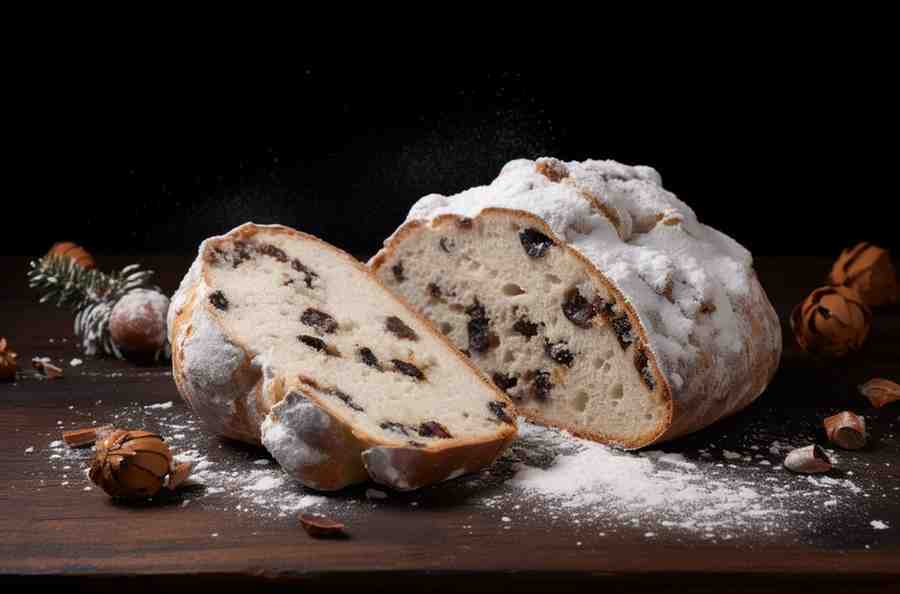Stollen, often called Christstollen, is a traditional German Christmas bread that has been enjoyed for centuries. Originating in Dresden, this festive bread features a delightful German Stollen recipe filled with a mix of dried fruits, nuts, and spices, and often incorporates a core of sweet marzipan. This German Stollen recipe is characterized by its buttery richness, spiced flavor, and distinctive powdered sugar coating, which resembles the snowy peaks of a German winter. Enjoying a slice of this classic German Stollen recipe is a delightful way to celebrate the festive season.
Key Ingredients for Stollen
German Stollen Recipe: A Festive Delight
Creating a delicious Stollen requires high-quality ingredients, each playing an important role in the bread’s texture and flavor. Below are the core components you’ll need for an authentic stollen.
The German Stollen recipe is a beloved tradition, often passed down through generations. With its rich history and festive flavors, this German Stollen recipe brings joy to many holiday gatherings.
Flour and Yeast for the Perfect Dough
Bread Flour
Bread flour is essential for stollen, as it has a higher protein content compared to all-purpose flour. This creates the chewy, elastic structure needed for a dough that can hold up to the rich fillings of dried fruits and nuts.
Active Dry Yeast
Yeast is key to giving stollen its light and fluffy texture. Use active dry yeast or instant yeast to ensure the dough rises properly. Make sure the yeast is fresh for the best results.
Dried Fruits and Nuts
Dried Fruits
Traditional stollen is filled with a mix of raisins, currants, and candied citrus peel. These fruits are often soaked in rum or brandy for extra flavor. You can also use dried cherries or cranberries for a modern twist.
Nuts
Chopped almonds or hazelnuts are often added to give the bread a delightful crunch. Toasting the nuts beforehand can enhance their flavor.
Spices and Flavorings
Spices
Stollen gets its signature warmth from a mix of aromatic spices, including cinnamon, nutmeg, and cardamom. These spices not only add flavor but also infuse the bread with the comforting aromas of the holiday season.
Marzipan (Optional)
For a more indulgent variation, roll marzipan into the dough. The sweet almond paste creates a rich and creamy center that contrasts beautifully with the chewy bread.
Butter and Sugar for Finishing
Butter
Brushing melted butter over the freshly baked stollen is a key step. The butter soaks into the bread, making it moist and rich.
Powdered Sugar
After buttering, dust the stollen generously with powdered sugar. The sugar coating is what gives stollen its iconic snow-covered appearance and adds a touch of sweetness.

Easy Stollen Recipe: A Simplified Approach
If you’re pressed for time or looking for a less labor-intensive option, this easy stollen recipe simplifies the traditional process without sacrificing flavor.
Preparing the Dough
- Mix Dry Ingredients: In a large bowl, whisk together 3 cups of bread flour, 1/2 cup of sugar, and 2 teaspoons of active dry yeast.
- Add Wet Ingredients: Warm 1/2 cup of milk and 1/2 cup of melted butter, then add them to the dry ingredients along with 1 teaspoon of vanilla extract. Mix until the dough begins to come together.
- Knead the Dough: Turn the dough out onto a floured surface and knead for 10 minutes until smooth and elastic.
Incorporating the Fruits and Nuts
- Prepare the Fruit Mixture: Soak 1 cup of mixed dried fruits (raisins, currants, and candied citrus peel) in 2 tablespoons of rum or orange juice for about 30 minutes.
- Add to the Dough: Gently fold the soaked fruits and 1/2 cup of chopped almonds into the dough.
Letting the Dough Rise
- First Rise: Place the dough in a lightly greased bowl, cover it with a clean towel, and let it rise in a warm place for about 1 hour or until it has doubled in size.
Shaping and Baking the Stollen
- Shape the Dough: After the first rise, punch down the dough and roll it into a rectangle. If using marzipan, roll a log of marzipan and place it in the center of the dough. Fold the dough over the marzipan, leaving one side slightly longer for the traditional stollen shape.
- Second Rise: Place the shaped dough on a baking sheet, cover, and let it rise for another 30 minutes.
- Bake: Preheat the oven to 180°C (350°F). Bake the stollen for 35-40 minutes, or until golden brown and cooked through.
Final Touch: Butter and Sugar Coating
- Brush with Butter: Immediately after removing the stollen from the oven, brush it generously with melted butter to lock in moisture.
- Dust with Powdered Sugar: Once cooled, dust the stollen with powdered sugar for a sweet, festive finish.
Traditional Stollen Recipe with Yeast
To make your own German Stollen recipe at home, gather the essential ingredients and follow the steps carefully to ensure the best results. This German Stollen recipe can easily become a family favorite.
For traditionalists, this German Stollen recipe is a must-try, as it uses yeast for a delightful rise and texture. Each bite of this German Stollen recipe will transport you to the festive markets of Germany.
For those who want to experience stollen as it’s been made for centuries, follow this traditional recipe that uses yeast for a slow fermentation process, resulting in a more complex flavor.
A sponge starter gives stollen its characteristic soft texture and slightly tangy flavor.
- Activate the Yeast: In a small bowl, dissolve 1 packet of active dry yeast in 1/4 cup of warm milk and 1 tablespoon of sugar. Let the mixture sit for 5-10 minutes until frothy.
- Create the Sponge: Add 1/2 cup of flour to the yeast mixture and stir to combine. Let it rest for 30 minutes, covered with a clean towel. This sponge will act as the base for your stollen dough.
Mixing the Dough
Once cooled, don’t forget to dust your German Stollen recipe with powdered sugar for that signature festive look.
- Combine Ingredients: In a large mixing bowl, combine 2 cups of flour, 1/2 cup of sugar, 1/2 cup of softened butter, 1 egg (or egg substitute), and the sponge starter. Mix until the dough starts to form.
- Add Fruits and Spices: Fold in 1 cup of soaked dried fruits, 1/2 cup of chopped almonds, 1 teaspoon of cinnamon, 1/4 teaspoon of nutmeg, and a pinch of cardamom.
- Knead the Dough: Turn the dough onto a floured surface and knead for 10 minutes until smooth and elastic.
First Rise
Preparing the Sponge Starter
- Let the Dough Rise: Place the dough in a lightly greased bowl, cover it, and let it rise for 1-2 hours, or until doubled in size.
Shaping and Baking the Traditional Stollen
- Shape the Dough: Once the dough has risen, punch it down and roll it into a rectangle. If you’re using marzipan, roll it into a log and place it in the center. Fold the dough over to encase the marzipan, leaving one side slightly longer for the traditional fold.
- Second Rise: Place the shaped dough on a baking sheet, cover it, and let it rise for 30 minutes.
- Bake the Stollen: Preheat your oven to 180°C (350°F). Bake the stollen for 35-40 minutes, or until golden brown.
Finishing Touch: Butter and Sugar Coating
- Brush with Butter: As soon as the stollen comes out of the oven, brush it with melted butter.
- Dust with Powdered Sugar: Once the stollen has cooled, dust it generously with powdered sugar for a festive finish. For an extra touch, dust again just before serving.
When preparing your German Stollen recipe, remember that patience is key. Allow your dough to rise properly for the best flavor in your German Stollen recipe.

Remember, every German Stollen recipe can reflect your personal touch, making it even more special for your loved ones.
Stollen Recipe with Yeast: Achieving the Perfect Rise
Using yeast is essential for creating the traditional stollen texture—a light, airy, and slightly chewy bread. However, working with yeast can be tricky, so it’s important to follow specific steps to ensure success.
Tips for Working with Yeast
Properly Activating the Yeast
To activate yeast, dissolve it in warm liquid (around 110°F/43°C). Make sure the liquid isn’t too hot, as this will kill the yeast and prevent the dough from rising. Always give the yeast a few minutes to froth and bubble before proceeding. If the mixture doesn’t foam, the yeast may be expired or inactive.
Patience During the Rise
Make sure to bake your German Stollen recipe until it’s perfectly golden, ensuring a soft and tender crumb inside.
After preparing your dough, allow it to rise until it has doubled in size, which can take between 1 to 2 hours. Make sure to place the dough in a warm, draft-free area to encourage proper fermentation. Using a covered bowl helps retain moisture and heat.
Common Yeast Issues and How to Fix Them
Why Isn’t My Dough Rising?
If your dough doesn’t rise, consider these potential issues:
- Expired Yeast: Always check the expiration date of your yeast before starting. If in doubt, try activating a small amount in warm water with sugar to test it.
- Temperature: If the room or the liquid used to activate the yeast is too cold, the dough won’t rise properly. Move the dough to a warmer location or gently warm the bowl.
How to Avoid Overproofing
Try using homemade marzipan in your German Stollen recipe for a truly authentic taste that elevates the entire experience.
Overproofing happens when dough rises for too long and then collapses during baking. Keep an eye on the dough as it rises—once it has doubled in size, it’s ready to be shaped and baked.
Stollen Variations: Customizing the Recipe
Stollen is versatile and can be customized to suit various tastes. Here are some popular variations to try:
To enhance the flavor of your German Stollen recipe, consider adding a splash of your favorite liqueur to the dried fruits during soaking.
With the right techniques and ingredients, your German Stollen recipe will impress everyone at your holiday festivities.
Marzipan Stollen
Adding Marzipan for Extra Richness
Sharing your German Stollen recipe with friends and family is a wonderful way to spread joy during the holiday season.
For a richer and sweeter version, Marzipan Stollen is a popular variation. Roll a log of marzipan and place it in the center of the dough before baking. The marzipan melts slightly during baking, creating a creamy, almond-flavored center that contrasts beautifully with the fruity dough.
For those who prefer a gluten-free option, experimenting with a gluten-free German Stollen recipe can yield delightful results.
Nut-Free Stollen
Removing Nuts for an Allergy-Friendly Option
For those with nut allergies, you can omit the nuts without losing the integrity of the recipe. Simply replace the almonds with extra dried fruit, such as dried cranberries or chopped dried apricots. This adds more sweetness and texture without the risk of allergens.
Gluten-Free Stollen
Using Gluten-Free Flour
To make the recipe gluten-free, replace traditional bread flour with a gluten-free all-purpose flour blend. For the best texture, add xanthan gum to mimic the elasticity that gluten provides. A teaspoon or two of xanthan gum ensures the dough holds together during baking and results in a light, chewy texture.
Whether you follow the traditional German Stollen recipe or create your own version, it’s sure to be a hit at any holiday gathering.
How to Store and Age Stollen for Maximum Flavor
This German Stollen recipe not only brings flavors together beautifully, but it also creates a wonderful aroma that fills your home during the holiday season.
One of the unique qualities of stollen is that it actually improves with time. After baking, stollen can be stored and aged, allowing the flavors to deepen and develop.
Storing Stollen at Room Temperature
Once cooled, wrap the stollen tightly in aluminum foil or plastic wrap, then store it in an airtight container. At room temperature, stollen can last for up to 2 weeks. The longer it sits, the more the flavors from the dried fruits, spices, and marzipan meld together.
Refrigerating or Freezing Stollen
The origins of the German Stollen recipe trace back centuries, each region adding its own twist to the traditional flavors.
For longer storage, refrigerate the stollen for up to 1 month. You can also freeze stollen for up to 3 months. To freeze, wrap the bread tightly in foil or plastic wrap, then place it in a freezer-safe bag or container. When ready to serve, thaw it at room temperature for several hours. If desired, dust with a fresh layer of powdered sugar just before serving.
FAQs About Stollen
Let’s dive into the most frequently asked questions about making and storing stollen:
Experiment with different variations of the German Stollen recipe to find your favorite combination of flavors and ingredients.
What is the Origin of Stollen Cake?
If you’re looking for a faster option, you can try a no-yeast version of the German Stollen recipe, but the classic method yields the best texture.
As you explore the world of baking, the German Stollen recipe should definitely be on your list of must-try recipes this season.
Stollen originated in Dresden, Germany, during the 14th century and was traditionally made to celebrate Christmas. It was originally a plain bread due to restrictions on the use of butter during Advent. However, when Pope Innocent VIII lifted the ban, stollen evolved into a rich, fruit-filled bread that became a holiday staple.
How Long Does Homemade Stollen Last?
Homemade stollen can last for several weeks due to the high-fat content from butter and dried fruits, which act as natural preservatives.
- At Room Temperature: Properly wrapped, it can last for up to 2 weeks.
- Refrigerated: When stored in the refrigerator, stollen can last for 1 month.
- Frozen: In the freezer, stollen remains fresh for up to 3 months. Thaw it fully before serving for the best texture.
Can I Make Stollen Without Yeast?
Yes, it’s possible to make a quicker version of stollen without yeast by using baking powder or baking soda as leavening agents. This method is great if you’re short on time, but the texture will be slightly denser than traditional yeast-risen stollen.
Quick No-Yeast Stollen Method:
- Replace the yeast with 1 tablespoon of baking powder.
- Combine all the ingredients as per the traditional recipe, but omit the rising times.
- Bake immediately after shaping for a denser, yet still flavorful, stollen.
What’s the Difference Between Stollen and Fruitcake?
Though both stollen and fruitcake are holiday desserts filled with dried fruits and nuts, there are several differences:
- Texture: Stollen is a yeast-risen bread with a light, airy crumb, whereas fruitcake is denser.
- Flavor: Stollen often includes marzipan and is spiced with cinnamon and cardamom, while fruitcake typically features rum or brandy-soaked fruits and heavier spices like cloves.
- Presentation: Stollen is dusted with powdered sugar to resemble a snowy log, while fruitcake is often topped with candied fruits.

